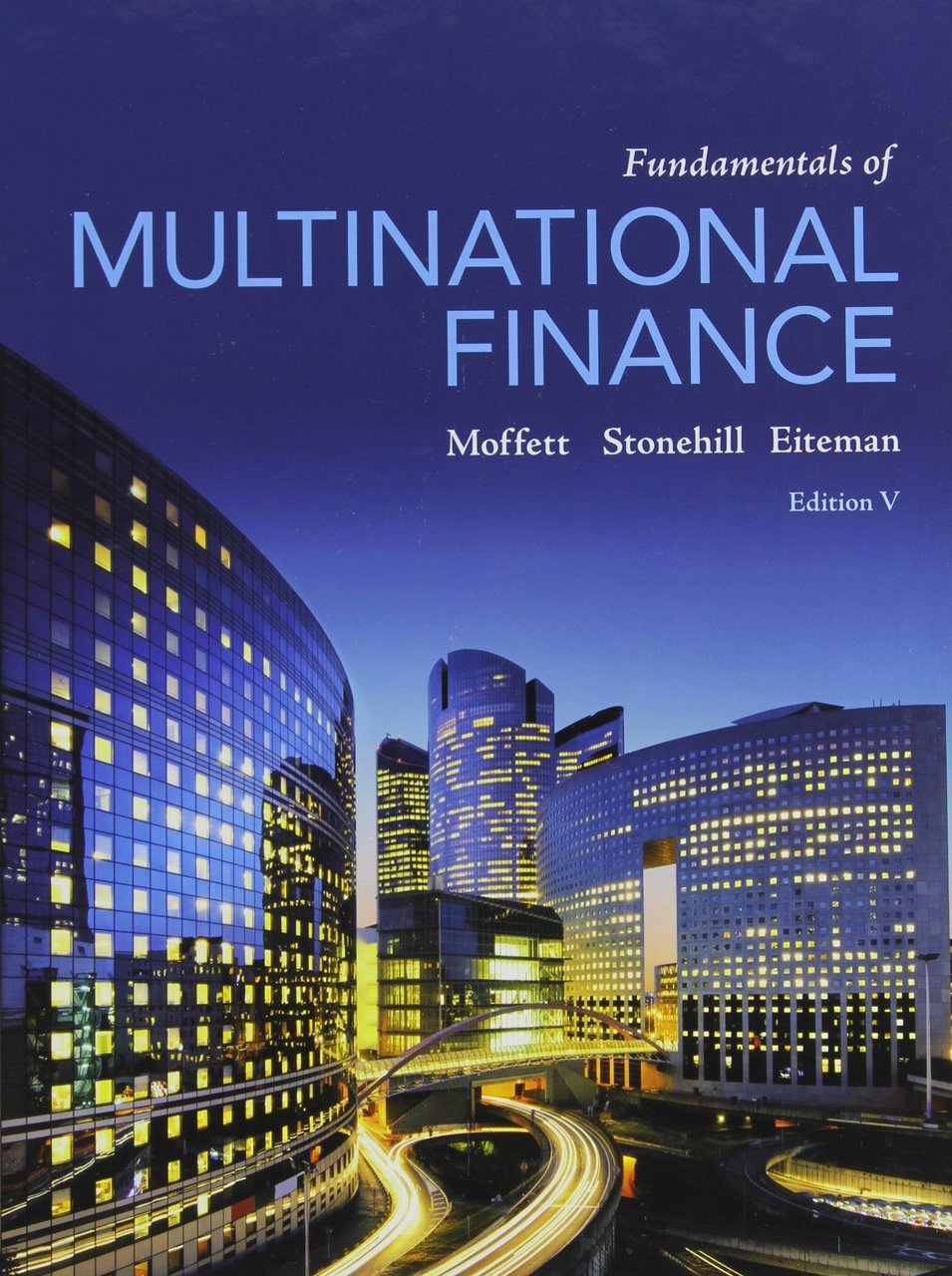This is completed downloadable of Fundamentals of Multinational Finance Moffett 5th Edition Solutions Manual

Product Details:
- ISBN-10 : 9780205989751
- ISBN-13 : 978-0205989751
- Author:
Fundamentals of Multinational Finance is intended for use in undergraduate International Financial Management, International Business Finance, or International Finance courses. It is also suitable for readers interested in global financial management.
A focused, streamlined approach to creating a global financial management strategy.
Tomorrow’s business leaders will be expected to comprehend global markets and lead their organizations through a constantly changing global environment. By grounding concepts in the context of illuminating case studies and real-world examples, Fundamentals of Multinational Finance familiarizes readers with the fundamental concepts and tools necessary to implement an effective global financial management strategy.
This edition includes the many new financial management challenges faced by today’s business leaders—while still providing readers with a streamlined text that gets straight to the important concepts.
Table of Content:
- PART 1 Global Financial Environment
- Chapter 1 Multinational Financial Management: Opportunities and Challenges
- Financial Globalization and Risk
- The Global Financial Marketplace
- GLOBAL FINANCE IN PRACTICE The Trouble with LIBOR
- The Theory of Comparative Advantage
- What Is Different about International Financial Management?
- GLOBAL FINANCE IN PRACTICE Corporate Responsibility and Corporate Sustainability
- Market Imperfections: A Rationale for the Existence of the Multinational Firm
- The Globalization Process
- Summary Points
- MINI-CASE Bitcoin—Cryptocurrency or Commodity?
- Questions
- Problems
- Internet Exercises
- Chapter 2 The International Monetary System
- History of the International Monetary System
- GLOBAL FINANCE IN PRACTICE Hammering Out an Agreement at Bretton Woods
- IMF Classification of Currency Regimes
- GLOBAL FINANCE IN PRACTICE Swiss National Bank Sets Minimum Exchange Rate for the Franc
- Fixed versus Flexible Exchange Rates
- GLOBAL FINANCE IN PRACTICE Who is Choosing What in the Trinity/Trilemma?
- A Single Currency for Europe: The Euro
- GLOBAL FINANCE IN PRACTICE The Euro and the Greek/EU Debt Crisis
- Emerging Markets and Regime Choices
- Globalizing the Chinese Renminbi
- Exchange Rate Regimes: What Lies Ahead?
- Summary Points
- MINI-CASE Russian Ruble Roulette
- Questions
- Problems
- Internet Exercises
- Chapter 3 The Balance of Payments
- Typical Balance of Payments Transactions
- Fundamentals of BOP Accounting
- The Accounts of the Balance of Payments
- GLOBAL FINANCE IN PRACTICE The Global Current Account Surplus
- GLOBAL FINANCE IN PRACTICE A Country’s Net International Investment Position (NiiP)
- BOP Impacts on Key Macroeconomic Rates
- Trade Balances and Exchange Rates
- Capital Mobility
- Summary Points
- MINI-CASE Global Remittances
- Questions
- Problems
- Internet Exercises
- Chapter 4 Financial Goals and Corporate Governance
- Who Owns the Business?
- The Goal of Management
- Publicly Traded versus Privately Held: The Global Shift
- Corporate Governance
- GLOBAL FINANCE IN PRACTICE Italian Cross-Shareholding and the End of the Salatto Buono
- GLOBAL FINANCE IN PRACTICE Is Good Governance Good Business Globally?
- Summary Points
- MINI-CASE Luxury Wars—LVMH vs. Hermès
- Questions
- Problems
- Internet Exercises
- PART 2 Foreign Exchange Theory and Markets
- Chapter 5 The Foreign Exchange Market
- Functions of the Foreign Exchange Market
- Structure of the Foreign Exchange Market
- GLOBAL FINANCE IN PRACTICE FX Market Manipulation: Fixing the Fix
- GLOBAL FINANCE IN PRACTICE My First Day of Foreign Exchange Trading
- Transactions in the Foreign Exchange Market
- Size of the Foreign Exchange Market
- Foreign Exchange Rates and Quotations
- GLOBAL FINANCE IN PRACTICE Russian Symbolism
- Summary Points
- MINI-CASE The Venezuelan Bolivar Black Market
- Questions
- Problems
- Internet Exercises
- Chapter 6 International Parity Conditions
- Prices and Exchange Rates
- GLOBAL FINANCE IN PRACTICE The Immiseration of the North Korean People—The “Revaluation” of th
- Interest Rates and Exchange Rates
- GLOBAL FINANCE IN PRACTICE Hungarian Mortgages
- Forward Rate as an Unbiased Predictor of the Future Spot Rate
- Prices, Interest Rates, and Exchange Rates in Equilibrium
- Summary Points
- Mini-Case Mrs. Watanabe and the Japanese Yen Carry Trade
- Questions
- Problems
- Internet Exercises
- Appendix: An Algebraic Primer to International Parity Conditions
- The Law of One Price
- Purchasing Power Parity
- Forward Rates
- Covered Interest Arbitrage (CIA) and Interest Rate Parity (IRP)
- Fisher Effect
- International Fisher Effect
- Chapter 7 Foreign Currency Derivatives and Swaps
- Foreign Currency Futures
- Currency Options
- GLOBAL FINANCE IN PRACTICE The New Zealand Kiwi, Key, and Krieger
- Option Pricing and Valuation
- Interest Rate Risk
- GLOBAL FINANCE IN PRACTICE A Fixed-Rate or Floating-Rate World?
- Interest Rate Derivatives
- Summary Points
- MINI-CASE McDonald’s Corporation’s British Pound Exposure
- Questions
- Problems
- Internet Exercises
- Chapter 8 Foreign Exchange Rate Determination
- Exchange Rate Determination: The Theoretical Thread
- Currency Market Intervention
- GLOBAL FINANCE IN PRACTICE Rules of Thumb for Effective Intervention
- Disequilibrium: Exchange Rates in Emerging Markets
- GLOBAL FINANCE IN PRACTICE Was George Soros to Blame for the Asian Crisis?
- Forecasting in Practice
- GLOBAL FINANCE IN PRACTICE JPMorgan Chase Forecast of the Dollar/Euro
- Summary Points
- Mini-Case The Japanese Yen intervention of 2010
- Questions
- Problems
- Internet Exercises
- PART 3 Foreign Exchange Exposure
- Chapter 9 Transaction Exposure
- Types of Foreign Exchange Exposure
- Why Hedge?
- Transaction Exposure Management: The Case of Trident
- Risk Management in Practice
- GLOBAL FINANCE IN PRACTICE Hedging and the German Automobile Industry
- GLOBAL FINANCE IN PRACTICE The Credit Crisis and Option Volatilities in 2009
- Summary Points
- MINI-CASE Banbury Impex (india)
- Questions
- Problems
- Internet Exercises
- Chapter 10 Translation Exposure
- Overview of Translation
- Translation Methods
- Trident Corporation’s Translation Exposure
- GLOBAL FINANCE IN PRACTICE Foreign Subsidiary Valuation
- Managing Translation Exposure
- GLOBAL FINANCE IN PRACTICE When Business Dictates Hedging Results
- Summary Points
- MINI-CASE LaJolla Engineering Services
- Questions
- Problems
- Internet Exercises
- Chapter 11 Operating Exposure
- A Multinational’s Operating Exposure
- GLOBAL FINANCE IN PRACTICE Expecting the Devaluation—Ford and Venezuela
- Measuring Operating Exposure: Trident Germany
- Strategic Management of Operating Exposure
- GLOBAL FINANCE IN PRACTICE Do Fixed Exchange Rates Increase Corporate Currency Risk in Emerging Mark
- Proactive Management of Operating Exposure
- Summary Points
- MINI-CASE Toyota’s European Operating Exposure
- Questions
- Problems
- Internet Exercises
- PART 4 Financing the Global Firm
- Chapter 12 The Global Cost and Availability of Capital
- Financial Globalization and Strategy
- International Portfolio Theory and Diversification
- The Demand for Foreign Securities: The Role of International Portfolio Investors
- The Cost of Capital for MNEs Compared to Domestic Firms
- The Riddle: Is the Cost of Capital Higher for MNEs?
- Summary Points
- MINI-CASE Novo Industri A/S (Novo)
- Questions
- Problems
- Internet Exercises
- Chapter 13 Raising Equity and Debt Globally
- Designing a Strategy to Source Capital Globally
- Optimal Financial Structure
- Optimal Financial Structure and the MNE
- Raising Equity Globally
- GLOBAL FINANCE IN PRACTICE The Planned Directed Equity Issue of PA Resources of Sweden
- Depositary Receipts
- Private Placement
- Foreign Equity Listing and Issuance
- Raising Debt Globally
- GLOBALl FINANCE IN PRACTICE Islamic Finance
- Summary Points
- MINI-CASE Petrobrás of Brazil and the Cost of Capital
- Questions
- Problems
- Internet Exercises
- Appendix: Financial Structure of Foreign Subsidiaries
- Local Norms
- Financing the Foreign Subsidiary
- Chapter 14 Multinational Tax Management
- Tax Principles
- Transfer Pricing
- GLOBAL FINANCE IN PRACTICE Offshore Profits and Dividend Repatriation
- Tax Management at Trident
- Tax-Haven Subsidiaries and International Offshore Financial Centers
- Summary Points
- MINI-CASE Google, Taxes, and “Do No Evil”
- Questions
- Problems
- Internet Exercises
- Chapter 15 International Trade Finance
- The Trade Relationship
- Benefits of the System
- Key Documents
- GlOBAL FINANCE IN PRACTICE Florence—The Birthplace of Trade Financing
- Documentation in a Typical Trade Transaction
- Government Programs to Help Finance Exports
- Trade Financing Alternatives
- GLOBAL FINANCE IN PRACTICE Factoring in Practice
- Forfaiting: Medium- and Long-Term Financing
- Summary Points
- MINI-CASE Crosswell International and Brazil
- Questions
- Problems
- Internet Exercises
- PART 5 Foreign Investment Decisions
- Chapter 16 Foreign Direct Investment and Political Risk
- Sustaining and Transferring Competitive Advantage
- The OLI Paradigm and Internationalization
- Deciding Where to Invest
- Modes of Foreign Investment
- Predicting Political Risk
- GLOBAL FINANCE IN PRACTICE Apache Takes a Hit from Egyptian Protests
- Firm-Specific Political Risk: Governance Risk
- Country-Specific Risk: Transfer Risk
- Country-Specific Risk: Cultural and Institutional Risk
- Global-Specific Risk
- GLOBAL FINANCE IN PRACTICE Drugs, Public Policy, and the Death Penalty in 2011
- Summary Points
- MINI-CASE Corporate Competition from the Emerging Markets
- Questions
- Internet Exercises
- Chapter 17 Multinational Capital Budgeting and Cross-Border Acquisitions
- Complexities of Budgeting for a Foreign Project
- Project versus Parent Valuation
- Illustrative Case: Cemex Enters Indonesia
- Project Financing
- Cross-Border Mergers and Acquisitions
- GLOBAL FINANCE IN PRACTICE Statoil of Norway’s Acquisition of Esso of Sweden
- Summary Points
- MINI-CASE Elan and Royalty Pharma
- Questions
- Problems
- Internet Exercises
- Answers
- Glossary
- A
- B
- C
- D
- E
- F
- G
- H
- I
- J
- K
- L
- M
- N
- O
- P
- Q
- R
- S
- T
- U
- V
- W
- Y
- Z
- Index
- A
- B
- C
- D
- E
- F
- G
- H
- I
- J
- K
- L
- M
- N
- O
- P
- Q
- R
- S
- T
- U
- V
- W
- Y





